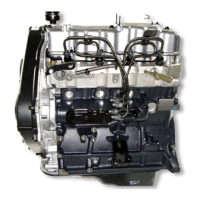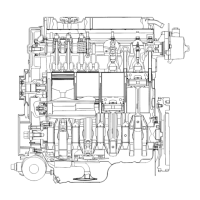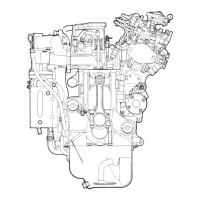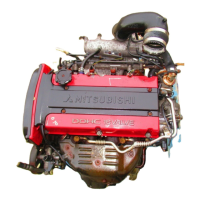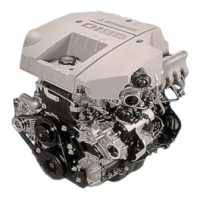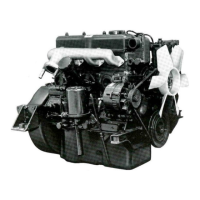
Do you have a question about the Mitsubishi 4DQ50 and is the answer not in the manual?
| Engine Model | 4DQ50 |
|---|---|
| Number of Cylinders | 4 |
| Cooling System | Water-cooled |
| Starting System | Electric starter |
| Engine Type | Diesel |
| Lubrication System | Forced lubrication |
Initial checks and preparations before using a new engine.
Pre-operation checks for engine oil, coolant, fuel, and power.
Procedures for starting the 4DQ50 engine using push button or key switches.
Warm-up procedure and checks after the engine has started.
How to operate the engine with pneumatic or mechanical governors.
Monitoring engine parameters like oil pressure, water temperature, and generator charge.
Proper procedure for shutting down the engine to prevent damage.
Specific instructions for starting and operating the engine in cold temperatures.
Recommendations for operating the engine during hot weather conditions.
Guidelines for selecting and using appropriate fuel for the engine.
Requirements for engine oil quality, viscosity, and recommended classes.
Guidance on when to change engine oil based on usage and testing.
Information on diaphragm oil for pneumatic governor lubrication.
Requirements for cooling water quality and handling of the cooling system.
Details on lubricating engine components, including oil pan and oil level checks.
Checking and changing oil in the fuel injection pump cam case.
Lubrication requirements for the pneumatic governor.
Lubrication of the mechanical governor and fuel injection pump.
Checking and changing oil for the oil bath type air cleaner.
Lubrication of the starter pinion shaft bearing.
Greasing the tension pulley when equipped.
Maintenance of the engine air intake system.
Details on oil and oil changes for the oil bath type air cleaner.
Handling and cleaning of the filter paper type air cleaner element.
Checking and adjusting valve clearances for optimal engine performance.
Measuring compression pressure to assess engine cylinder health.
Overview of the engine's forced lubrication system.
Procedures for checking oil level and changing oil in the oil pan.
Maintenance and replacement procedures for the oil filter element.
Function and purpose of the differential bypass valve in the oil filter.
Monitoring oil pressure and troubleshooting low oil pressure issues.
Description of the engine's fuel delivery system.
Maintenance and replacement of the fuel filter element.
Procedure for bleeding air from the fuel system.
Inspecting and servicing fuel injection nozzles for proper function.
Maintenance and troubleshooting of the fuel injection pump.
Adjusting the fuel injection timing for optimal engine performance.
Explanation of the pneumatic governor's structure and operation.
Description of the mechanical governor's structure and operation.
Function of the automatic timer for adjusting injection timing.
Maintenance of the engine's cooling water circulation system.
Maintenance of the cooling water system and radiator for efficient cooling.
Checking and servicing the thermostat for proper engine temperature regulation.
Adjusting fan belt tension for optimal cooling system performance.
Overview of the engine's electrical system components.
Description and maintenance of the DC generator.
Description and maintenance of the AC generator.
Maintenance and troubleshooting of the starter motor.
Maintenance and care of the engine battery.
Procedure for tightening cylinder head clamp bolts to specified torque.
Checking and tightening bolts on main bearing and connecting rod caps.
Keeping other essential bolts and nuts tight for engine integrity.
A comprehensive chart to diagnose and resolve engine problems.
Additional diagnostic information for troubleshooting engine issues.
General guidelines and conditions requiring engine overhaul.
Procedures for refacing valve seats and replacing valve guides.
Removal and installation of rocker shaft brackets.
Procedures for removing and installing pistons and connecting rods.
Information on cylinder oversizes and replacement of cylinder liners.
General cautions and handling of bearing metals during assembly.
Details on the timing gear train and its components.
Diagram and procedure for checking and setting valve timing.
Proper installation of oil seals on the crankshaft.
Guidelines for setting engine mountings.
Procedures for correctly installing the engine oil pan.
Installation of the oil pump case cover.
Procedure for disassembling, servicing, and reassembling the water pump.
Torque specifications and procedures for screwing various bolts.
General specifications for the engine, including speed and pressure.
Specifications for pistons, rings, and piston pins.
Specifications for the crankshaft and its bearings.
Standards for checking the Venturi or Governor.
Standards for checking and adjusting bearing clearances.
Standards for piston pins and their replacement limits.
List of common tools required for routine engine servicing.
List of special tools available for engine overhauling.
Key technical specifications of the Mitsubishi Diesel Engine Model 4DQ50.
Performance data for various applications like generators and construction equipment.

